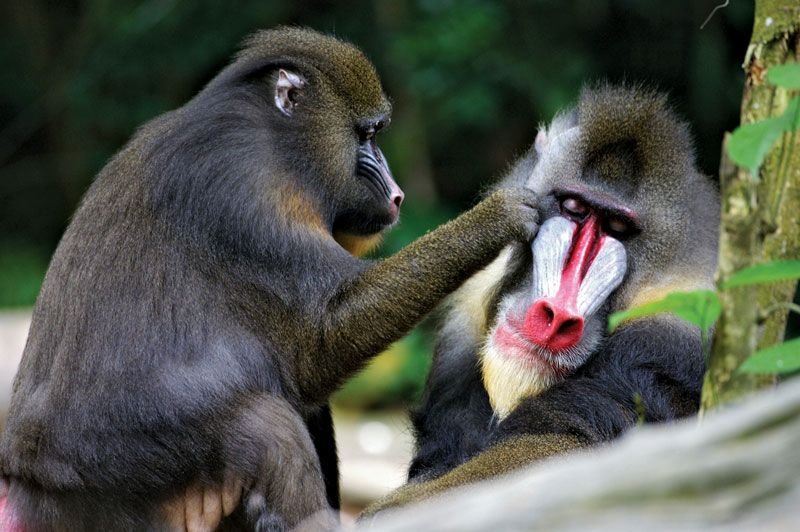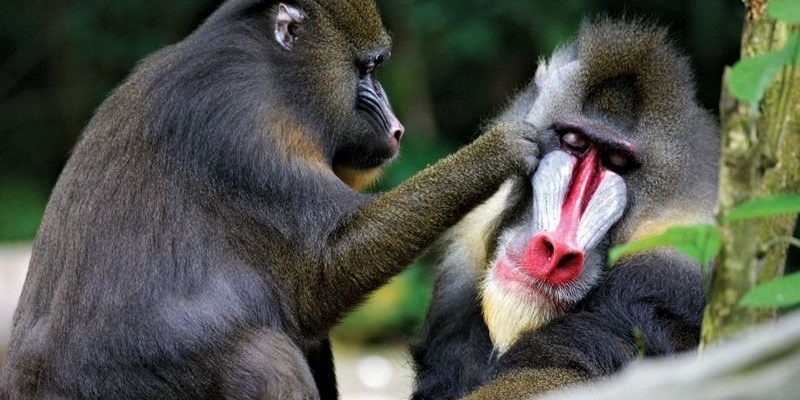
Mandrills, with their complex social structures and behaviors, are much more than just colorful creatures in a zoo. They inhabit dense rainforests in Central Africa, where survival isn’t just about food or shelter. It’s about navigating social dynamics, communicating effectively, and making decisions that can impact their group. Think of them as the social butterflies of the primate world, where understanding who’s who and what’s what is key to thriving in their environment.
What Are Mandrills? A Quick Overview
Mandrills are the largest species of monkey and belong to the Old World monkey family. Native to the rainforests of Central Africa, these creatures are known for their distinctive features. Imagine a monkey with a bright blue and red face, a beard, and a body covered in a mix of black and brown fur. Those glorious colors are not just for show. They play a significant role in communication and social interactions among mandrills.
These primates primarily live in large troops, ranging from 20 to over 200 individuals. Their structure is quite hierarchical. Males are typically larger and more dominant, often with vibrant markings that help assert their status within the troop. You might be wondering how this social hierarchy impacts their behavior and intelligence. Well, it plays a crucial role in how they interact, form bonds, and solve problems together.
Cognitive Abilities of Mandrills
When we talk about the intelligence of mandrills, we’re diving into several aspects, such as memory, problem-solving skills, and social cognition. Memory is one of their key strengths. They can remember faces and recognize individual members of their troop, even after long periods. This ability helps them navigate complex relationships and maintain their social structure.
In terms of problem-solving, mandrills show an impressive knack for finding food. They can use tools, such as sticks, to extract insects or reach fruits. This behavior isn’t just instinctive; it indicates a level of cognitive processing that involves planning and reasoning. Imagine a child figuring out how to use building blocks to reach a cookie jar—it’s a similar kind of cleverness!
Additionally, their social cognition is remarkable. They communicate through vocalizations, gestures, and facial expressions, which are essential for maintaining troop dynamics. By interpreting these signals, mandrills can gauge emotions and intentions, helping them respond appropriately in various situations.
Social Structure and Its Impact on Intelligence
The complex social structure of mandrills deeply influences their cognitive abilities. Living in large troops means they’re constantly interacting with other members. This social engagement encourages skills like communication, empathy, and even strategic thinking. The need to navigate social hierarchies and alliances makes each mandrill a bit smarter in dealing with everyday challenges.
Let’s break this down. In a troop, a dominant male might need to deal with challengers for his status. This scenario isn’t just about brawn; it involves mental agility. The dominant male must decide when to assert his power and when to avoid confrontation, weighing risks and rewards. It’s like playing a game of chess, where every move matters.
Additionally, females often play pivotal roles in social bonding. They nurture and care for their young while navigating friendships and rivalries. This dynamic creates an environment where learning from one another flourishes. There’s an age-old saying that “it takes a village,” and in the mandrill world, that couldn’t be more accurate.
Communication Skills: More Than Just Sounds
Mandrills are talkative creatures, but their communication goes beyond mere vocalizations. They use a rich variety of sounds, body language, and facial expressions to convey messages. Each sound has its purpose—some alarm calls warn of predators, while others express excitement or distress. Imagine being in a crowded room, understanding exactly what everyone is saying without them using words; that’s kind of what mandrills do!
Their expressive faces are a significant part of their communication toolbox. The vibrant colors and features serve not only to attract mates but also to convey emotional states. A mandrill showing off its colorful face might be signaling aggression or confidence, while a softer expression could indicate submission or fear. This rich tapestry of communication enhances their social interactions and strengthens bonds within the troop.
Interestingly, research suggests that mandrills can even adapt their communication based on the audience. They might change their vocalizations when interacting with younger or older troop members. This adaptability shows a level of intelligence that’s quite impressive and highlights their understanding of social contexts.
Learning and Cultural Behaviors Among Mandrills
Cultural behaviors—those learned practices that are passed down generations—are seen in mandrills, much like in humans. They learn from observing their peers, which is essential for their survival. For instance, young mandrills watch older members to learn which foods are safe to eat and how to use different tools. This mentorship is crucial in helping them develop their skills and knowledge.
Imagine a young child learning to cook by watching their parents. Similarly, young mandrills mimic the actions of adults, soaking in information that will help them thrive in the wild. This kind of learning is a crucial element of their cognitive abilities and shows a depth of intelligence that many might not expect from a non-human primate.
Moreover, some mandrill behaviors can vary between different troops or regions, indicating localized cultural practices. For example, one troop might have a favorite foraging technique that another doesn’t use. These learned behaviors contribute to their adaptability and survival in different environments.
Challenges to Mandrills’ Intelligence and Survival
Despite their impressive cognitive abilities, mandrills face significant threats due to habitat loss and poaching. As their rainforest homes shrink, their complex social structures and learning opportunities are disrupted. This loss can have long-term effects on their intelligence and behavior. It’s like suddenly taking away a classroom from students—learning opportunities get severely limited.
Additionally, as their social groups diminish, the remaining mandrills may struggle to find mates and maintain their social dynamics. This can lead to decreased genetic diversity, impacting their adaptability and resilience. The very essence of what makes mandrills intelligent and socially savvy is under threat.
Conservation efforts are critical to ensuring that these unique primates can continue to thrive. It’s essential to protect their habitats and raise awareness about the importance of biodiversity. After all, keeping mandrills around is not just about saving a species; it’s about preserving the remarkable intelligence and behavior that they bring to the tapestry of life on Earth.
In exploring how smart mandrills really are, we uncover a world rich with social intricacies and cognitive skills. Their ability to communicate, learn, and navigate complex social structures makes them stand out in the animal kingdom. Just like us, they rely on social interactions to grow and adapt.
So, the next time you see a mandrill—perhaps at a zoo or in a documentary—take a moment to appreciate not just its striking appearance, but the impressive intelligence behind those vivid colors. Their story is a reminder of the incredible complexity of nature and the importance of protecting such fascinating creatures for future generations to learn from and enjoy.

